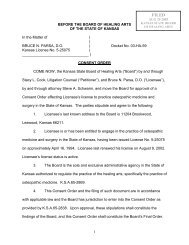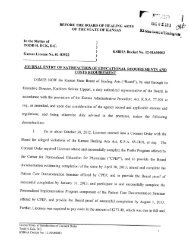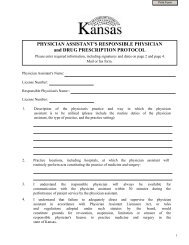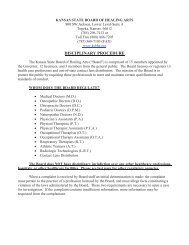ksbha guidance document index - Kansas State Board of Healing Arts
ksbha guidance document index - Kansas State Board of Healing Arts
ksbha guidance document index - Kansas State Board of Healing Arts
Create successful ePaper yourself
Turn your PDF publications into a flip-book with our unique Google optimized e-Paper software.
esponsible handling <strong>of</strong> medications ( 4) compliance with all elements <strong>of</strong> the treatment plan (including<br />
recovery-oriented activities, psychotherapy and/or other psychosocial modalities) and (5) abstinence from<br />
illicit drug use. If reasonable treatment goals are not being achieved, the physician should re-evaluate the<br />
appropriateness <strong>of</strong> continued treatment.<br />
• Consultation<br />
The physician should refer the patient as necessary for additional evaluation and treatment in order to<br />
achieve treatment objectives. The physician should pursue a team approach to the treatment <strong>of</strong> opioid<br />
addiction, including referral for counseling and other ancillary services. Ongoing communication between<br />
the physician and consultants is necessary to ensure appropriate compliance with the treatment plan. This<br />
may be included in the formal treatment agreement between the physician and patient. Special attention<br />
should be given to those patients who are at risk for misusing their medications and those whose living or<br />
work arrangements pose a risk for medication misuse or diversion. The management <strong>of</strong> addiction in<br />
patients with comorbid psychiatric disorders requires extra care, monitoring, <strong>document</strong>ation and<br />
consultation with or referral to a mental health pr<strong>of</strong>essional.<br />
• Medical Records<br />
The prescribing physician should keep accurate and complete records to include ( 1) the medical history and<br />
physical examination; (2) diagnostic, therapeutic and laboratory results; (3) evaluations and consultations;<br />
(4) treatment objectives; (5) discussion <strong>of</strong> risks and benefits; (6) treatments; (7) medications (including<br />
date, type, dosage, and quantity prescribed and/or dispensed to each patient); (8) a physical inventory <strong>of</strong> all<br />
Schedules III, IV, and V controlled substances on hand that are dispensed by the physician in the course <strong>of</strong><br />
maintenance or detoxification treatment <strong>of</strong> an individual; (9) instructions and agreements; and ( 1 0) periodic<br />
reviews. Records should remain current and be maintained in an accessible manner and readily available<br />
for review. The physician must adhere to the special confidentiality requirements <strong>of</strong> 42CFR, Part 2, which<br />
apply to the treatment <strong>of</strong> drug and alcohol addiction, including the prohibition against release <strong>of</strong> records or<br />
other information, except pursuant to a proper patient consent or court order in full compliance with<br />
42CFR2, or the Federal or <strong>State</strong> <strong>of</strong>ficials listed in 42CFR2, or in cases <strong>of</strong> true medical emergency or for the<br />
mandatory reporting <strong>of</strong> child abuse.<br />
Section Ill: Definitions<br />
For the purposes <strong>of</strong> these guidelines, the following terms are defined as follows:<br />
Addiction: A primary, chronic, neurobiologic disease, with genetic, psychosocial, and environmental<br />
factors influencing its development and manifestations. It is characterized by behaviors that include one or<br />
more <strong>of</strong> the following: impaired control over drug use, compulsive use, continued use despite harm and<br />
cravmg.<br />
Agonists: Agonist drugs are substances that bind to the receptor and produce a response that is similar in<br />
effect to the natural ligand that would activate it. Full mu opioid agonists activate mu receptors, and<br />
increasing doses <strong>of</strong> full agonists produce increasing effects. Most opioids that are abused, such as<br />
morphine and heroin are full mu opioid agonists.<br />
"Approved Schedule 111-V Opioids": Opioids referred to by the DATA, specifically approved by the<br />
FDA for treatment <strong>of</strong> opioid dependence or addiction.<br />
Antagonists: Antagonists bind to but do not activate receptors. They prevent the receptor from being<br />
activated by an agonist compound. Examples <strong>of</strong> opioid antagonists are naltrexone and naloxone.








